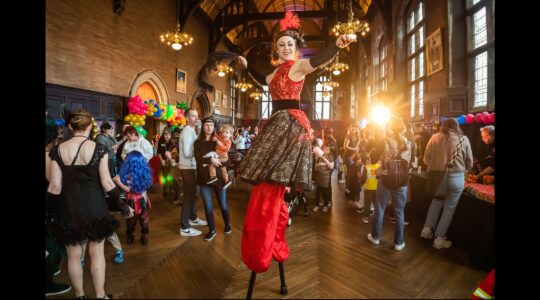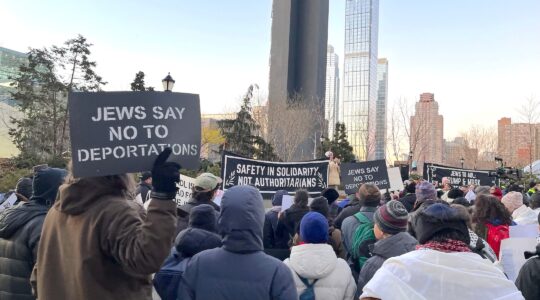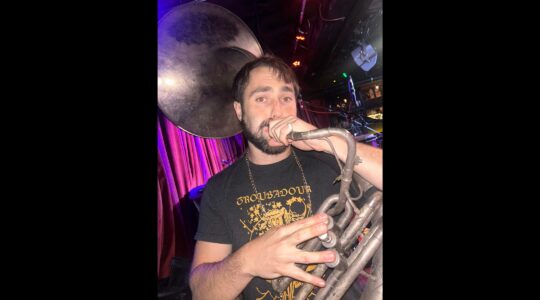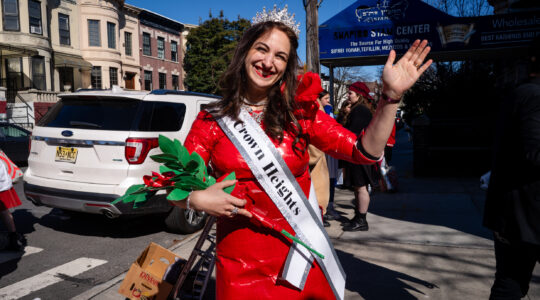Two uniformed guards recently stopped Michal Rovner as she tried to enter the third-floor galleries at the Whitney Museum of American Art. "We’re sorry, ma’am," Rovner said she was told, "the galleries are closed." To get through security, the diminutive Israeli-born artist simply looked up. Taped to the wall (in expectation of an upcoming exhibition) was a sign bearing her name.
Fifteen years after moving to New York and committing to life as an artist, Rovner has achieved what most artists dream of: a retrospective at one of the nation’s premier museums. "Michal Rovner: The Space Between" opens next week with over 60 photographic works, 11 monoprints, and three video installations, including Rovner’s newest piece, "Time Left."
"It’s beginning to sink in," Rovner told The Jewish Week, as she and four assistants juggled the exhibition’s final details: down to finalizing guest lists for opening-night parties and choosing the right matte black paint for the walls where "Time Left" will be projected. The work, which debuts at the Whitney, will fill one room with images of hazy human forms, hands joined and moving in processions around the four walls.
Rovner created "Time Left" in an emotional response to the ongoing violence in Israel and to 9-11, which she witnessed from the roof of her Bleecker Street studio. She shot most of the footage, however, in Romania and the frozen countryside outside Moscow.
"My work is never about location," she says. "It could be any place."
It is precisely this "aura of universality," as the Whitney curator’s of photography, Sylvia Wolf, describes it, that many people associate with Rovner’s work: whether her subject is flocks of birds, an abandoned Bedouin house, or groups of people moving in unspecified migrations.
Rovner begins with actual footage (bodies floating in the Dead Sea or New Yorkers trudging through a snowstorm) and uses those images as a point of departure. In the editing room, she manipulates the recorded human and animal figures so they become what the painter Leon Golub calls "ciphers." She strips the landscape of discernible features, adding colors chosen according to her emotional response, and evocative soundtracks, such as helicopter blades or swarming insects. As with "Time Left," Rovner breaks apart and fuses different realities to create a new one.
"The power of her art," Wolf writes in the catalogue for the show, "lies in an open-ended narrative that transcends place and in an exoticism that asks viewers to give themselves over to a world outside their experience."
Rovner did just that in 1987, when nearly 30 years old, she left Israel for New York. "I was canceling one lifetime, one lifestyle, one life in favor of creating a new one which did not yet exist," the artist told Wolf.
At the time, Rovner was teaching at Camera Obscura, now Israel’s largest school of visual media, which she founded in 1978 as the country’s first professional darkroom space with her then-boyfriend (now ex-husband), Arie Hammer. But during a visit to New York, she was drawn to the city’s grit, its honesty and its respect for artistic endeavor.
"In Israel, my neighbor asked me, ‘What about your life? You’re missing the train,’ " she said in a recent interview. "He was talking about marriage and family. I said, ‘I’m already on another train.’ "
Within six years of settling in New York, the iconoclast was the subject of a one-artist photography show at the Art Institute of Chicago, which Wolf curated. Moving into videography during the past five years, Rovner’s work has premiered at The Tate Gallery in London, the Stedelijk Museum in Amsterdam, the Museum of Modern Art in New York and the 2000 Whitney Biennial. Her monumental projects have been projected on the windows of the Chase Manhattan Bank building on Park Avenue and installed at the Mitzpe Ramon Crater in the Negev Desert.
In presenting a survey of Rovner’s art, the Whitney is placing her in the field of significant foreign-born artists working in America. But some people find more immediate significance in "The Space Between."
"In light of what is happening now, the violence, the conflict going on in Israel," says Shoshana Blank, an Israeli-born art dealer in Los Angeles who represents Rovner, "it’s important to show the other side of Israelóthat it’s not all about violence, that there is also humanity and art."
Rovner says she regards herself as living several realities at once. "I am an American artist and I am an Israeli person," she says, adding after a pause, "and other persons you meet along the way."
Today she is listed as a farmer in Israel, because she owns a six-acre farm in the Valley of Ayalon. "In Israel, I’m not considered a serious artist."
Rovner, however, is nothing if not serious. And those who know her attest to her intensity. She has been known to carry on simultaneous conversations in Hebrew and English on separate phones, and to travel from Los Angeles to northern California twice in two days in order to get the perfect shot of flying birds.
From the time she was a child, she has been "stingy" about her time, impatient for friends to leave so that she could return to her projects. In her busiest periods, she survives on half-hour catnaps. "The only time I feel I’m not wasting time is when I’m doing this," she says, sweeping her arm around the walls of her white studio.
Born in 1957, Rovner grew up in Ramat-Chen, now a suburb of Tel Aviv. She spent much of her childhood in the fields surrounding the house where she lived with her parents, Jacob and Ruth, and two older siblings. "A field for me is always a very creative zone," she says.
That’s clear in such haunting works as "Overhanging" (1999), "Co-Existence 2" (2000) and "Notes" (2001), which she created for the composer Philip Glass. Seen from a distance through Rovner’s lens, shadowy figures move through abstractly defined landscapes, tinged with desert heat or blanched by bitter snows.
Less creative was the formal atmosphere of Tel Aviv University, where Rovner studied philosophy, cinema and television in 1981, or the Bezalel Academy of Art, where she graduated in 1985. In her work Rovner has had to "erase" much of what she was taught. Many of her most fertile experiences had nothing to do with art, she says. "Some might be just an experience or a slight moment, and suddenly you get a huge idea."
While many people identify Rovner’s work with the human experience in general, explicit events have at times spurred her to creative action. In 1991, she took photographs of the TV news coverage of the Gulf War to create "Decoy." In 1996, she began making "Border," her first video project. The 48-minute "fictional documentary" approaches the Israel-Lebanon border from three points of view: footage shot by a team of filmmakers, by an Israeli Army commander, and by Rovner herself.
More recently, Rovner says she was moved to create a work reflecting "the impact of last year’s events on me." The result: "Time Left."
Rovner usually declines to provide strict interpretations of her work, but offers some options for viewers of her latest piece. "You could see the figures themselves, the wave [of movement], a flag, a script," she says. The rows and rows of figures holding hands are "like writing, the evidence of something," she says.
The installation employs new technologies to create a seamless projection, without any break between frames and without a dissolve. The effect is "foreverness," Rovner says, adding that if she had to choose among all the works in the Whitney exhibition, "I would shows only this."
The exhibition "Michal Rovner: The Space Between" is on view July 11 through Oct. 13, at the Whitney Museum of American Art, 945 Madison Ave. at 75th Street, Man. (800) 944-8639. Tue.-Thu., Sat. and Sun, 11 a.m.-6 p.m.; Fri. 1-9 p.m. $12, $9.50 students and seniors. Pay what you wish Fri. after 6 p.m.
The New York Jewish Week brings you the stories behind the headlines, keeping you connected to Jewish life in New York. Help sustain the reporting you trust by donating today.




